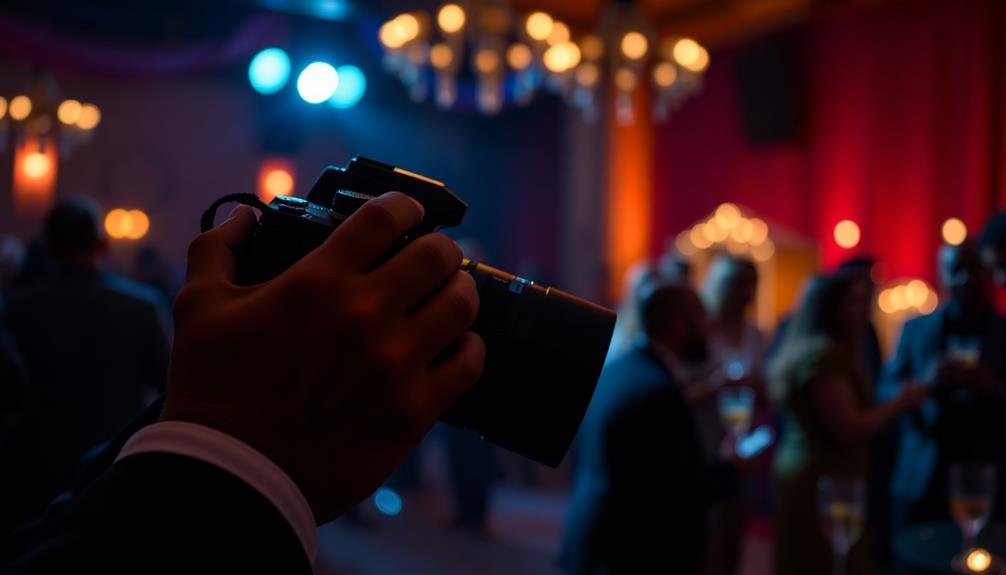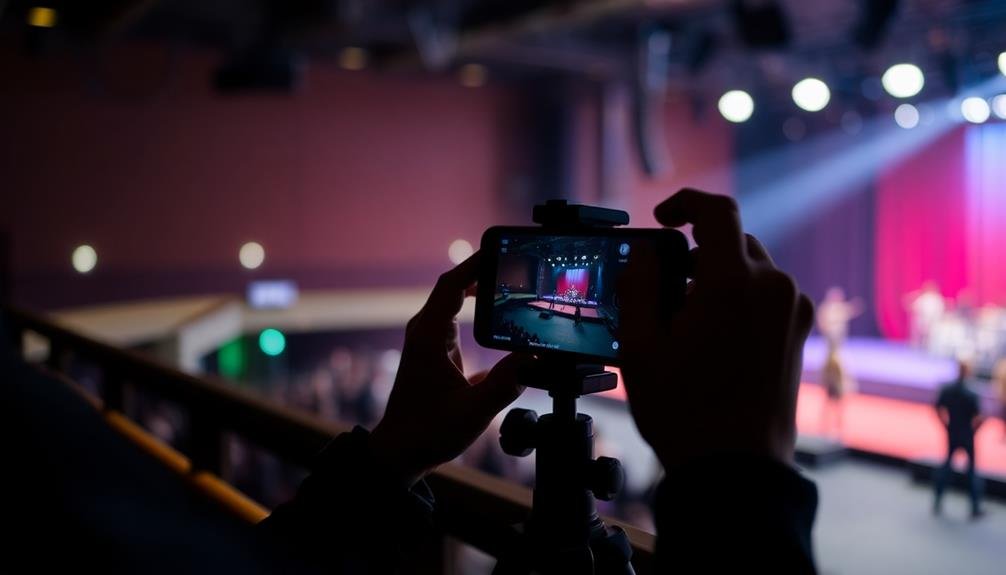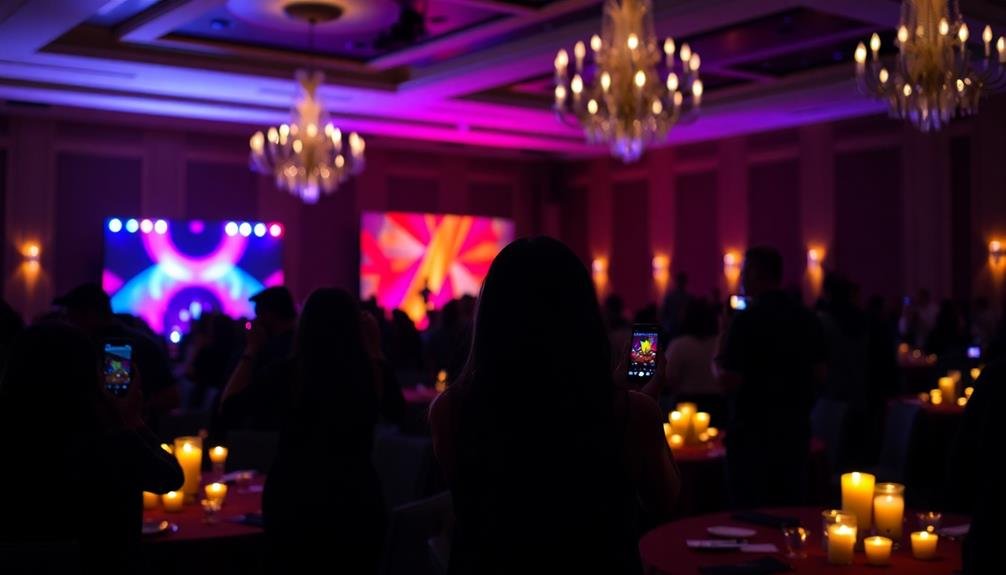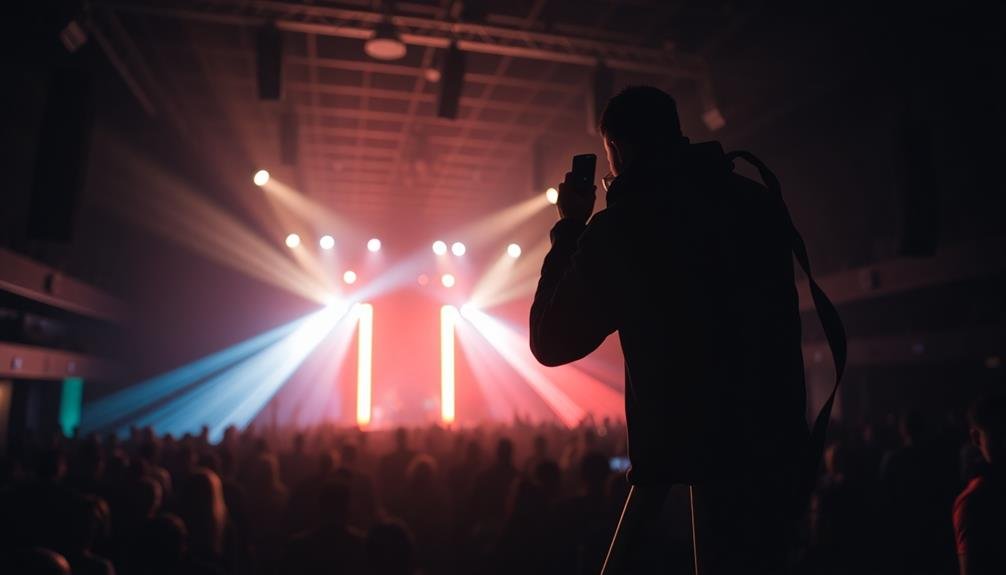To capture stunning event photos in night mode, start by mastering your camera's low-light settings. Increase ISO sensitivity, open your aperture wide, and slow down your shutter speed for ideal exposure. Next, focus on stabilizing your smartphone or camera. Use both hands, lean against solid surfaces, or invest in a tripod to minimize shake. Finally, make the most of available light sources. Position subjects near ambient lighting, like streetlamps or neon signs, to add depth and color to your shots. By applying these three key techniques, you'll elevate your night event photography from ordinary to extraordinary. Dive deeper to reveal even more secrets for capturing the perfect nocturnal moments.
Master Low-Light Camera Settings

How do you capture stunning event photos in low light? Start by mastering your camera's essential settings. Set your ISO higher, typically between 800 and 3200, to increase light sensitivity. However, be cautious of excessive noise at extremely high ISOs.
Open your aperture wide (f/2.8 or lower) to let in more light and create a shallow depth of field. Slow down your shutter speed, but not too much to avoid motion blur. A rule of thumb is to keep it at 1/focal length or faster.
Switch to manual mode for full control over exposure. Use spot metering to measure light on your subject's face accurately. Shoot in RAW format to retain more data for post-processing.
Enable your camera's noise reduction feature, but be aware it may slow down shooting speed. Don't forget about white balance. Set it manually or use a preset like "tungsten" for indoor events.
Experiment with your camera's night mode or low-light scene settings. They can often produce surprisingly good results. Finally, invest in fast lenses (f/1.8 or wider) to maximize light-gathering capabilities and improve overall image quality in challenging lighting conditions.
Stabilize Your Smartphone

Three key techniques can help you stabilize your smartphone for crisp night event photos.
First, use both hands to grip your phone firmly, keeping your elbows close to your body. This creates a natural tripod effect, reducing camera shake.
Second, lean against a stable surface like a wall or pillar when possible. This additional support minimizes body movement, resulting in sharper images.
Third, invest in a smartphone tripod or gimbal for ultimate stability. These accessories allow for hands-free operation and can greatly improve your low-light photography. When using a tripod, enable your phone's timer or use a Bluetooth remote to avoid touching the device during capture.
If you don't have a tripod, improvise with everyday objects. Rest your phone on a table, ledge, or even a friend's shoulder. Use your phone's volume buttons or voice commands to trigger the shutter without touching the screen.
Remember to hold your breath momentarily while taking the shot to further reduce movement.
With practice, these techniques will become second nature, helping you capture stunning night event photos with your smartphone.
Utilize Available Light Sources

While darkness may seem challenging for event photography, you can leverage existing light sources to create stunning images. Look for ambient lighting like streetlamps, neon signs, or decorative lights at the event venue. These can provide interesting color casts and create dramatic shadows, adding depth to your photos.
Position your subjects near these light sources to illuminate their faces naturally. If you're shooting indoors, windows can offer soft, diffused light during twilight hours. Don't shy away from artificial lighting either; stage lights, disco balls, or even smartphone screens can become creative light sources for your shots.
When utilizing available light, be mindful of white balance. Different light sources emit various color temperatures, which can affect the overall mood of your image. Experiment with your camera's white balance settings or use the auto white balance feature if you're unsure.
Remember to expose for the highlights to avoid blown-out areas in your photos. This may mean underexposing slightly, but you can bring out details in the shadows during post-processing.
Frequently Asked Questions
How Do I Prevent Motion Blur in Night Mode Photos of Moving Subjects?
To prevent motion blur in night mode photos of moving subjects, you'll want to use a faster shutter speed. Increase your ISO, open your aperture wider, and consider using flash. Panning techniques can also help capture movement effectively.
Can I Use Night Mode for Indoor Events With Dim Lighting?
Yes, you can use night mode for indoor events with dim lighting. It'll help capture more light and detail. However, be aware that moving subjects may appear blurry. Try increasing ISO or using a flash for better results.
What's the Best Way to Capture Fireworks or Light Shows at Night?
To capture fireworks or light shows at night, you'll want to use a tripod and long exposure settings. Set your camera to manual mode, use a low ISO, narrow aperture, and experiment with shutter speeds between 2-10 seconds.
How Do I Balance Flash With Night Mode for Better Portraits?
To balance flash with night mode for better portraits, you'll want to use a lower flash power setting. Experiment with rear-curtain sync and slow shutter speeds. This'll help blend ambient light with your flash, creating more natural-looking nighttime portraits.
Are There Any Accessories That Enhance Smartphone Night Mode Capabilities?
You can enhance your smartphone's night mode with accessories like clip-on lenses, tripods, and external lights. Don't forget a power bank to keep shooting. Some phones even support external flashes for better low-light portraits.
In Summary
You've now got the tools to capture stunning event photos in low light. Remember to adjust your camera settings, keep your smartphone steady, and make the most of available light sources. Don't be afraid to experiment and push your creativity. With practice, you'll soon be producing professional-quality night mode images that truly capture the essence of any event. So get out there, embrace the darkness, and start shooting some unforgettable nighttime moments!





Leave a Reply